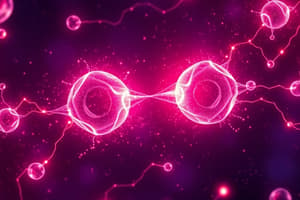Podcast
Questions and Answers
What is the relationship between surface temperature and the rate of emission of infrared radiation?
What is the relationship between surface temperature and the rate of emission of infrared radiation?
- Surface temperature has no impact on the rate of emission.
- Higher surface temperature leads to a lower rate of emission.
- Rate of emission is constant regardless of temperature.
- Higher surface temperature leads to a higher rate of emission. (correct)
Which type of wave travels in the direction that is perpendicular to the direction of oscillation?
Which type of wave travels in the direction that is perpendicular to the direction of oscillation?
- Longitudinal waves
- Mechanical waves
- Transverse waves (correct)
- Surface waves
What does a displacement-distance graph illustrate?
What does a displacement-distance graph illustrate?
- The amplitude of a wave in relation to its frequency.
- The displacement of all particles at a particular point in time. (correct)
- The energy spectrum of a wave.
- The speed of a wave over time.
Which of the following characteristics defines longitudinal waves?
Which of the following characteristics defines longitudinal waves?
What happens to the rate of emission of infrared radiation as the temperature relative to the surroundings increases?
What happens to the rate of emission of infrared radiation as the temperature relative to the surroundings increases?
What is the main characteristic of a covalent bond?
What is the main characteristic of a covalent bond?
Which statement correctly describes ionic compounds?
Which statement correctly describes ionic compounds?
What forces hold together the atoms within a simple molecular structure?
What forces hold together the atoms within a simple molecular structure?
What is a defining feature of macromolecules?
What is a defining feature of macromolecules?
What type of arrangement do carbon atoms have in graphite?
What type of arrangement do carbon atoms have in graphite?
Which of the following best describes the forces between molecules in a simple molecular structure?
Which of the following best describes the forces between molecules in a simple molecular structure?
What role do positive and negative ions play in ionic bonding?
What role do positive and negative ions play in ionic bonding?
What can be said about silicon dioxide (SiO2)?
What can be said about silicon dioxide (SiO2)?
What effect does a higher temperature have on the speed of sound in air?
What effect does a higher temperature have on the speed of sound in air?
Why does sound travel faster in solids than in liquids or gases?
Why does sound travel faster in solids than in liquids or gases?
What is an echo?
What is an echo?
What happens to air density when humidity increases?
What happens to air density when humidity increases?
Which medium has the fastest approximate speed for sound transmission?
Which medium has the fastest approximate speed for sound transmission?
What characterizes a concentrated acid?
What characterizes a concentrated acid?
Which of the following describes a strong acid?
Which of the following describes a strong acid?
How is basicity defined for an acid?
How is basicity defined for an acid?
What distinguishes a weak acid from a strong acid?
What distinguishes a weak acid from a strong acid?
Which of the following compounds are considered neutral oxides?
Which of the following compounds are considered neutral oxides?
What defines a salt in chemistry?
What defines a salt in chemistry?
What is the reaction product of an alkali reacting with an acid?
What is the reaction product of an alkali reacting with an acid?
Which method would you use to prepare an insoluble salt?
Which method would you use to prepare an insoluble salt?
Which of the following statements about bases is true?
Which of the following statements about bases is true?
When preparing salts, which of the following methods requires the presence of Group 1 or ammonium ions?
When preparing salts, which of the following methods requires the presence of Group 1 or ammonium ions?
What is a common characteristic of strong alkalis?
What is a common characteristic of strong alkalis?
How do weak alkalis differ from strong alkalis in solution?
How do weak alkalis differ from strong alkalis in solution?
In the standard procedure for preparing an insoluble salt via precipitation, what is the first step?
In the standard procedure for preparing an insoluble salt via precipitation, what is the first step?
Which statement about the preparation of soluble salts using acids and excess solids is correct?
Which statement about the preparation of soluble salts using acids and excess solids is correct?
What is the product of the reaction between an acid and an insoluble metal based on the general rules?
What is the product of the reaction between an acid and an insoluble metal based on the general rules?
What is the main factor that determines the method of preparing a salt?
What is the main factor that determines the method of preparing a salt?
Flashcards are hidden until you start studying
Study Notes
Ionic and Covalent Bonding
- Charge balance is crucial; total positive charges must equal total negative charges in ionic compounds.
- Sodium (Na) contributes one electron while Fluorine (F) accepts it; visual representation uses dots (F) and crosses (Na).
- Ionic structures involve electrostatic attraction between positive and negative ions, creating a strong intermolecular force.
- Giant ionic crystal lattice forms a three-dimensional structure, where ions alternate in arrangement.
Covalent Bonding
- Covalent bonds result from the sharing of valence electrons between two non-metal atoms, with each atom providing one electron.
- The bond is a strong attraction between an atom's nucleus and the shared electron pair.
- Molecules form from covalent bonding to achieve a stable noble gas electron configuration with a full shell.
Molecular Structures
- Simple molecules have small discrete structures; strong covalent bonds hold atoms together while weak intermolecular forces hold different molecules together.
- Macromolecules possess a giant covalent structure, consisting of a large network of atoms linked by strong covalent bonds.
Allotropes of Carbon
- Diamond: Each carbon atom forms four strong covalent bonds in a tetrahedral structure, resulting in remarkable hardness.
- Graphite: Carbon atoms are arranged in layers with hexagonal rings; strong in-layer covalent bonds but weak intermolecular forces allow layers to slide.
Silicon Dioxide (SiO2)
- Composed of silicon and oxygen atoms; silicon bonds with four oxygens, and each oxygen connects to two silicon atoms.
- Common forms include sand and quartz.
Acid Strength and Concentration
- Acid concentration refers to the amount of acid dissolved in a solvent; concentrated acids contain a large solute amount in a small volume.
- Acid strength indicates the degree of ionization in water:
- Strong acids fully ionize, producing many H+ ions (e.g., hydrochloric, sulfuric, nitric acids).
- Weak acids partially ionize, providing fewer H+ ions (e.g., ethanoic acid, citric acid).
Acid-Base Chemistry
- Acids dissociate in water, while bases (metal oxides/hydroxides) lead to the release of hydroxide ions (OH-).
- Strong alkalis fully dissociate in water, e.g., sodium hydroxide, while weak alkalis dissociate partially.
- Alkalis have a bitter taste, soapy feel, and turn red litmus paper blue, with pH values above 7.
Neutralization Reactions
- Alkalis neutralize acids, producing salt and water as byproducts.
- In reactions with ammonium salts, alkalis also produce ammonia.
Salts and Preparation
- Salts are ionic compounds formed when hydrogen ions in acids are replaced by metallic or ammonium ions.
- Three methods to prepare salts:
- Precipitation for insoluble salts.
- Acid plus excess solid for soluble salts containing Group 1/Ammonium ions.
- Titration for soluble salts without Group 1/Ammonium ions.
Precipitation Method
- Mixing two aqueous solutions forms an insoluble salt, which is filtered and washed.
Acid plus Excess Solid
- Required for preparing soluble salts, ensuring complete reaction with the acid.
General Wave Properties
- Waves transfer energy without the physical transport of matter.
- Transverse waves oscillate perpendicular to energy transfer (e.g., electromagnetic waves).
- Longitudinal waves oscillate parallel to energy transfer (e.g., sound waves).
Sound Propagation
- Speed of sound varies in different media: approximately 300-340 m/s in air, 1500-1600 m/s in liquid, and 5000-6000 m/s in solids.
- Increased temperature and lower density in air enhance sound transmission speed.
Reflection of Sound
- Echoes occur when sound reflects off hard, flat surfaces, often perceived softer due to energy loss during reflection.
Studying That Suits You
Use AI to generate personalized quizzes and flashcards to suit your learning preferences.




